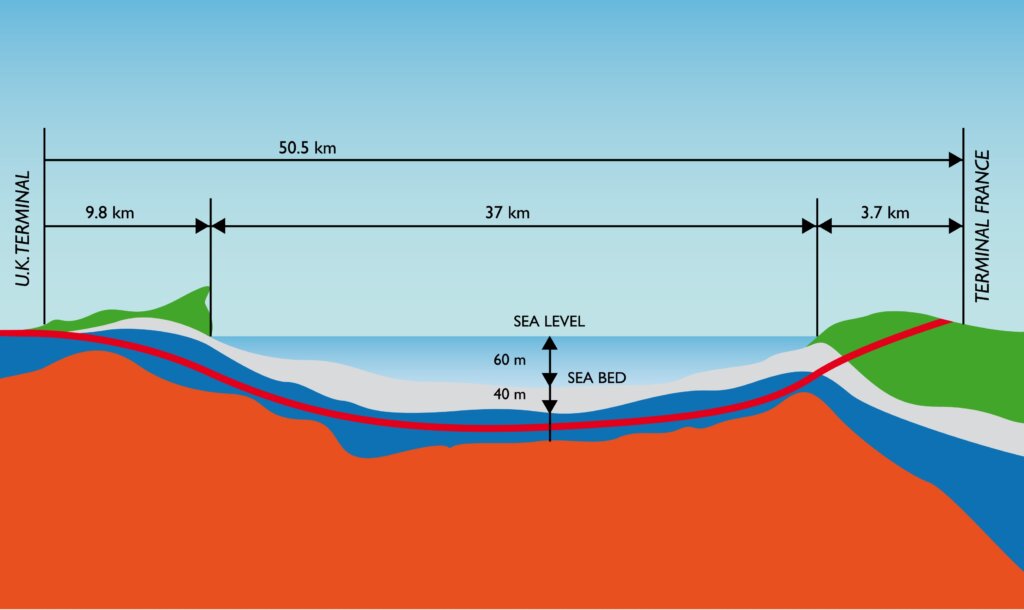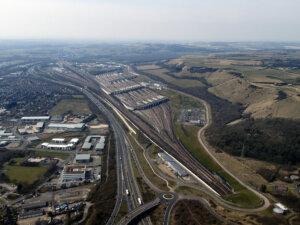The Channel Tunnel—commonly known as the “Chunnel”—is one of the most impressive engineering feats of the modern era. That’s not just our subjective opinion either; it was named one of the Seven Wonders of the Modern World by the American Society of Civil Engineers. The ASCE refers to it as “engineering magic” and they have a point – constructing an underwater tunnel beneath the English Channel sounded like a plot point from a Sci Fi novel.
The magic in question is a series of innovative construction techniques, and careful safety precautions that made the Chunnel possible. Let’s explore the story of the Chunnel’s construction, with a particular focus on the safety measures taken and the revolutionary techniques that made it possible.
History of the Chunnel Project
The idea of a tunnel connecting England and France had been discussed for centuries, but it wasn’t until the 20th century that serious plans started to take shape. The first concrete (pun intended) proposal for the Channel Tunnel was made in 1802 by French mining engineer Albert Mathieu. He envisioned a tunnel with horse-drawn carriages and an artificial island in the middle of the channel for changing horses and ventilation. Shockingly, it wasn’t building an equine oasis in frigid North Sea waters that made the project impossible. Political tensions between the two countries and concerns over national security halted any progress; after all, this is the era of the Napoleonic Wars we’re talking about.
UK: “I say old boy, shouldn’t we build a faster way to get back and forth between our two nations? Taking a 7 hour boat ride every time I want a decent bottle of Burgundy wreaks absolute havoc on my wig.”
France: “Ah oui, mon ami, there we are completely in l’accord. A tunnel betwixt us would solve many problems.”
UK: “Wait a tick – you won’t use it to, let’s say, invade England will you?”
France:
UK: “Will you??”
Suffice it to say, the right call was made. Over the years, there were several other proposals and even some initial construction attempts. In the late 19th century, a pilot tunnel was started but was never completed due to political and financial reasons. It wasn’t until 1986 that the Channel Tunnel Act was passed in both the UK and France (one of the few things the famously unpopular Margaret Thatcher did that met with near-unanimous approval). A consortium of British and French construction companies formed Eurotunnel and were awarded the contract to build the tunnel.
Construction began in 1988 and was divided into three sections: the tunnel under the English Channel, the two undersea approach tunnels, and the link between the two national networks. Over 15,000 workers from both countries worked tirelessly to complete the project.
The construction process was complex and challenging, with crews facing harsh conditions and difficult terrain. Despite the difficulties, the project was completed in just over six years, with the tunnel opening for passenger services in 1994.
The completion of the Chunnel marked a significant milestone in transportation history. It provided a direct link between the UK and France, accounting for €138 billion in trade and transporting 21 million passengers each year. Financially, the project was a massive undertaking. Initially budgeted at £4.65 billion, the final cost was closer to £9 billion, an overrun of about 80%, thanks in part to the unprecedented construction challenges and innovative (aka ‘not cheap’) solutions to them.
The Safety Risks Involved in Building the Chunnel

Building the Chunnel was no easy feat, and it came with a range of safety risks that had to be carefully managed. One of the major challenges was the construction process itself. Workers had to navigate through various geological formations, including chalk and clay, which presented a constant threat of collapse. Additionally, the tunnels were built at depths of up to 75 meters below sea level, making it difficult for workers to quickly escape in the event of an emergency.
Another safety risk was the presence of water. The English Channel is known for its unpredictable tides and strong currents, which posed a significant danger during construction. The risk of flooding was always present, and workers had to constantly monitor water levels to ensure their safety.
Fire safety was another major concern. The Chunnel is a confined space with limited ventilation, making it susceptible to the rapid spread of fire. To address this risk, a sophisticated fire detection and suppression system was installed throughout the tunnel. This system included heat detectors, smoke detectors, and water mist sprays to extinguish any potential fires.
In addition to these risks, there were also concerns about the well-being of the workers themselves. The construction process required long hours and demanding physical labor, which increased the risk of accidents and injuries. To mitigate these risks, strict safety protocols were put in place, including regular safety training and the use of personal protective equipment.
Innovations in safety during the construction of the Chunnel
One major innovation in safety was the use of tunnel boring machines (TBMs). These powerful machines helped to excavate the tunnel by removing the soil and rock while simultaneously building the tunnel walls. By using TBMs, workers were able to avoid potentially hazardous manual excavation methods. The TBMs also had advanced safety features (especially advanced when you consider we’re talking about 1988), such as sensors that detected any obstructions or potential collapses, ensuring the safety of the workers operating the machines.
Another important innovation was the introduction of the “slurry shield” method. This method involved pumping a stabilizing mixture of bentonite clay and water into the ground to prevent collapses during excavation. This created a protective layer around the tunnel walls, reducing the risk of cave-ins and ensuring the safety of the workers.
In addition to these innovations, the construction of the Chunnel saw the implementation of strict safety protocols and regular safety inspections. Workers were trained extensively in safety procedures and were required to wear personal protective equipment at all times.
Regular safety drills and emergency response training were also conducted to ensure that workers were prepared for any situation.
Water, Water, Everywhere
During the construction of the Channel Tunnel, workers encountered zones of permeable chalk filled with water under high pressure. This posed a significant risk as the water could flood the tunnel, endangering workers and halting construction. To create a safe environment for tunneling through these water-bearing zones, engineers decided to use the ground freezing technique.
Ground freezing is a method used to stabilize the ground and prevent water ingress by turning the water in the soil into ice. This is achieved by circulating a refrigerant (often brine or liquid nitrogen) through a series of pipes that are drilled into the ground. As the refrigerant circulates, it absorbs heat from the surrounding soil, causing the water in the soil to freeze. This creates an “ice wall” or a frozen barrier around the construction area.
Pipes were drilled around the section of the tunnel where water ingress was a concern. Liquid nitrogen was then circulated through these pipes, rapidly cooling the surrounding ground and freezing the water in the chalk. This created a solid, impermeable barrier of frozen ground, allowing workers to safely excavate and construct the tunnel without the risk of flooding.
Fire Safety in the Chunnel
A sophisticated fire detection and suppression system was installed throughout the Chunnel, consisting of heat detectors and smoke detectors that were strategically placed to quickly identify any signs of a fire. In addition, water mist sprays were installed to immediately extinguish any potential fires.
The confined space of the Chunnel presented a challenge for fire safety. To address this, the tunnel was divided into fire compartments that could be isolated in the event of a fire. This prevented the rapid spread of fire throughout the entire tunnel and allowed for a controlled response to the situation.
Regular fire drills were also conducted to ensure that workers were well-prepared in case of an emergency. These drills allowed workers to practice evacuation procedures and familiarize
themselves with the emergency exits and evacuation routes in the tunnel.
The Role of Technology During Chunnel Construction
Throughout the construction of the Chunnel, technology played a vital role in ensuring the safety of the workers and the successful completion of the tunnel. From advanced monitoring systems to state-of-the-art machinery, innovative technologies were employed to minimize risks and enhance safety measures.
One of the key technologies used in the Chunnel project was advanced monitoring systems. These systems included sensors that constantly monitored the structural integrity of the tunnel and alerted workers to any potential collapses or obstructions. This real-time data allowed for immediate action to be taken to address any safety concerns.
In addition to monitoring systems, the use of tunnel boring machines (TBMs) was another technological breakthrough. These powerful machines not only expedited the excavation process but also increased safety for workers. TBMs were equipped with advanced safety features such as obstruction detectors, which helped prevent accidents and ensured the safety of those operating the machines.
The Chunnel incorporated cutting-edge fire detection and suppression systems. These systems included heat detectors, smoke detectors, and water mist sprays that were strategically placed throughout the tunnel. In the event of a fire, these systems would detect and extinguish it quickly, minimizing the risk to workers and the tunnel itself.
Technology also played a role in communication and emergency response. The Chunnel was equipped with a comprehensive emergency communication system, including emergency phones placed strategically along the tunnel. This allowed workers to quickly alert the control center in case of any emergencies, ensuring a swift response.
The Chunnel stands as a testament to the power of technology in ensuring safety. The use of advanced monitoring systems, tunnel boring machines, fire detection systems, and emergency communication systems all contributed to a safe working environment and the successful completion of the tunnel.
Emergency Evacuation Plans and Procedures in the Chunnel
Hope for the best, plan for the worst. Emergency evacuation plans in the Chunnel were carefully designed to ensure a swift and orderly evacuation in case of any unforeseen circumstances. Every worker involved in the construction process was trained on these evacuation plans and procedures to ensure they were prepared for any situation that may arise.
The tunnel was equipped with a comprehensive emergency communication system that allowed workers to quickly alert the control center in case of an emergency. This system included emergency phones strategically placed throughout the tunnel, enabling workers to call for help or report any incidents.
In the event of an evacuation, the tunnel was divided into sections to facilitate an organized exit. Evacuation routes and emergency exits were clearly marked and easily accessible. Regular drills and exercises were conducted to familiarize workers with the evacuation procedures and to ensure they could safely and efficiently evacuate the tunnel if necessary.
Isn’t it Ironic?
A trivia fun fact to close with: Graham Fagg is a retired English miner, who was the “breakthrough” worker – he and French counterpart Phillipe Cozette made contact and exchanged flags 40 meters beneath the seabed. Despite playing such a pivotal role in this symbol of England’s connection to the continent, Fagg voted in favour of Brexit.

